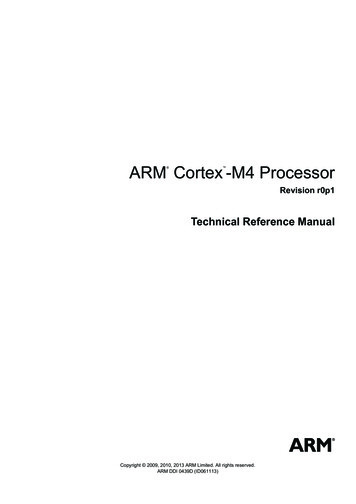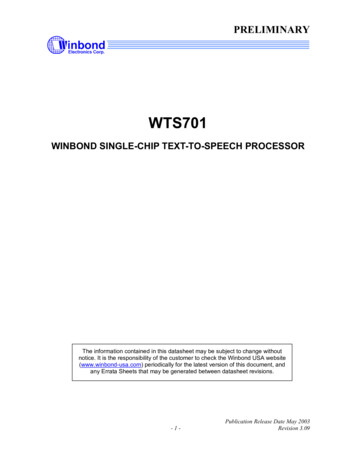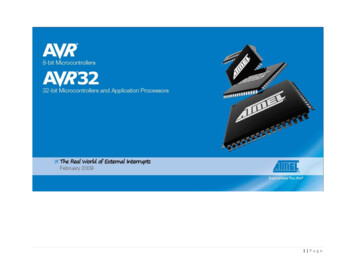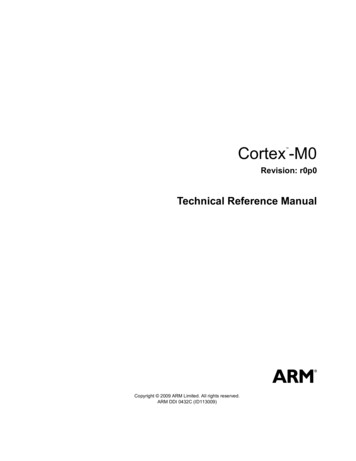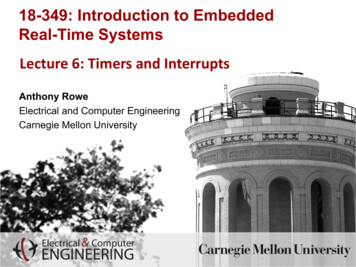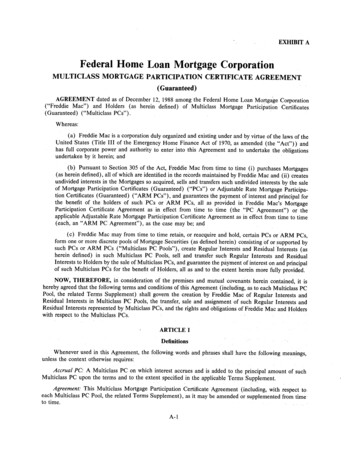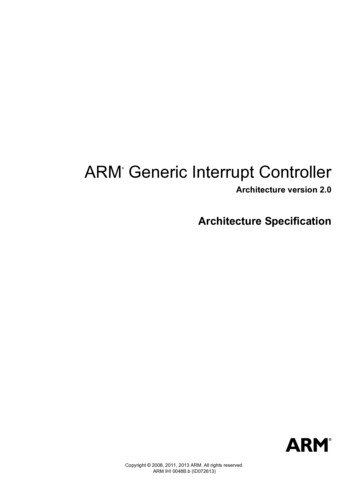
Transcription
ARM Generic Interrupt Controller Architecture version 2.0Architecture SpecificationCopyright 2008, 2011, 2013 ARM. All rights reserved.ARM IHI 0048B.b (ID072613)
ARM Generic Interrupt ControllerCopyright 2008, 2011, 2013 ARM. All rights reserved.Release InformationThe following changes have been made to this document.Change HistoryDateIssueConfidentialityChange23 September 2008ANon-ConfidentialFirst release for version 1.013 June 2011BNon-ConfidentialFirst release for version 2.026 July 2013B.bNon-ConfidentialRe-release of issue B with new Proprietary NoticeStatus of Issue B.b of this documentIssue B.b of this document is a re-issue of issue B incorporating the updated Propriatary Notice for the document.Beyond page four of the document the only changes between issue B and issue B.b are: Changes to the page footers to show the new version number, copyright dates, and ID code. Changed page numbering, because of the longer Propriatary Notice. A statement in Appendix C Revisions that there are no technical changes between issue B and issue B.b.Proprietary NoticeARM GENERIC INTERRUPT CONTROLLER (GIC) ARCHITECTURE SPECIFICATION LICENCETHIS END USER LICENCE AGREEMENT ("LICENCE") IS A LEGAL AGREEMENT BETWEEN YOU (EITHER ASINGLE INDIVIDUAL, OR SINGLE LEGAL ENTITY) AND ARM LIMITED ("ARM") FOR THE USE OF THE RELEVANTGIC ARCHITECTURE SPECIFICATION ACCOMPANYING THIS LICENCE. ARM IS ONLY WILLING TO LICENSE THERELEVANT GIC ARCHITECTURE SPECIFICATION TO YOU ON CONDITION THAT YOU ACCEPT ALL OF THETERMS IN THIS LICENCE. BY CLICKING "I AGREE" OR OTHERWISE USING OR COPYING THE RELEVANT GICARCHITECTURE SPECIFICATION YOU INDICATE THAT YOU AGREE TO BE BOUND BY ALL THE TERMS OF THISLICENCE. IF YOU DO NOT AGREE TO THE TERMS OF THIS LICENCE, ARM IS UNWILLING TO LICENSE THERELEVANT GIC ARCHITECTURE SPECIFICATION TO YOU AND YOU MAY NOT USE OR COPY THE RELEVANTGIC ARCHITECTURE SPECIFICATION AND YOU SHOULD PROMPTLY RETURN THE RELEVANT GICARCHITECTURE SPECIFICATION TO ARM."LICENSEE" means You and your Subsidiaries."Subsidiary" means, if You are a single entity, any company the majority of whose voting shares is now or hereafter owned orcontrolled, directly or indirectly, by You. A company shall be a Subsidiary only for the period during which such control exists.1.2.iiSubject to the provisions of Clauses 2, 3 and 4, ARM hereby grants to LICENSEE a perpetual, non-exclusive,non-transferable, royalty free, worldwide licence to:a.use and copy the relevant GIC Architecture Specification for the purpose of developing and having developedproducts that comply with the relevant GIC Architecture Specification;b.manufacture and have manufactured products which either: (i) have been created by or for LICENSEE under thelicence granted in Clause 1a; or (ii) incorporate a product(s) which has been created by a third party(s) under alicence granted by ARM in Clause 1a of such third party’s ARM GIC Architecture Specification Licence; andc.offer to sell, sell, supply or otherwise distribute products which have either been (i) created by or for LICENSEEunder the licence granted in Clause 1a; or (ii) manufactured by or for LICENSEE under the licence granted inClause 1b.LICENSEE hereby agrees that the licence granted in Clause 1 is subject to the following restrictions:a.where a product is created under Clause 1a or manufactured under Clause 1b it must contain at least one processorcore which has either been (i) developed by or for ARM; or (ii) developed under licence from ARM;b.the licences granted in Clause 1c shall not extend to any portion or function of a product that is not itself compliantwith part of the relevant GIC Architecture Specification; andc.no right is granted to LICENSEE to sublicense the rights granted to LICENSEE under this Agreement.Copyright 2008, 2011, 2013 ARM. All rights reserved.Non-ConfidentialARM IHI 0048B.bID072613
3.Except as specifically licensed in accordance with Clause 1, LICENSEE acquires no right, title or interest in any ARMtechnology or any intellectual property embodied therein. In no event shall the licences granted in accordance with Clause1 be construed as granting LICENSEE, expressly or by implication, estoppel or otherwise, a licence to use any ARMtechnology except the relevant GIC Architecture Specification.4.THE RELEVANT GIC ARCHITECTURE SPECIFICATION IS PROVIDED "AS IS" WITH NO WARRANTIESEXPRESS, IMPLIED OR STATUTORY, INCLUDING BUT NOT LIMITED TO ANY WARRANTY OFSATISFACTORY QUALITY, MERCHANTABILITY, NONINFRINGEMENT OR FITNESS FOR A PARTICULARPURPOSE.5.No licence, express, implied or otherwise, is granted to LICENSEE, under the provisions of Clause 1, to use the ARMtradename in connection with the relevant GIC Architecture Specification or any products based thereon. Nothing inClause 1 shall be construed as authority for LICENSEE to make any representations on behalf of ARM in respect of therelevant GIC Architecture Specification.6.This Licence shall remain in force until terminated by you or by ARM. Without prejudice to any of its other rights ifLICENSEE is in breach of any of the terms and conditions of this Licence then ARM may terminate this Licenceimmediately upon giving written notice to You. You may terminate this Licence at any time. Upon expiry or terminationof this Licence by You or by ARM LICENSEE shall stop using the relevant GIC Architecture Specification and destroyall copies of the relevant GIC Architecture Specification in your possession together with all documentation and relatedmaterials. Upon expiry or termination of this Licence, the provisions of clauses 6 and 7 shall survive.7.The validity, construction and performance of this Agreement shall be governed by English Law.ARM contract references: LES-PRE-20079 ARM GENERIC INTERRUPT CONTROLLER (GIC) ARCHITECTURESpecification Licence.Where the term ARM is used it means “ARM or any of its subsidiaries as appropriate”.NoteThe term ARM can refer to versions of the ARM architecture, for example ARMv6 refers to version 6 of the ARM architecture.The context makes it clear when the term is used in this way.ARM IHI 0048B.bID072613Copyright 2008, 2011, 2013 ARM. All rights reserved.Non-Confidentialiii
ivCopyright 2008, 2011, 2013 ARM. All rights reserved.Non-ConfidentialARM IHI 0048B.bID072613
ContentsARM Generic Interrupt Controller ArchitectureSpecificationPrefaceAbout this specification . viiiUsing this specification . ixConventions . xAdditional reading . xiFeedback . xiiChapter 1Introduction1.11.21.31.4Chapter 2About GIC partitioning . 2-22The Distributor . 2-24CPU interfaces . 2-26Interrupt Handling and Prioritization3.13.23.33.43.53.63.7ARM IHI 0048B.bID0726131-141-161-171-18GIC Partitioning2.12.22.3Chapter 3About the Generic Interrupt Controller architecture .Security Extensions support .Virtualization support .Terminology .About interrupt handling and prioritization .General handling of interrupts .Interrupt prioritization .The effect of interrupt grouping on interrupt handling .Interrupt grouping and interrupt prioritization .Additional features of the GIC Security Extensions .Pseudocode details of interrupt handling and prioritization .Copyright 2008, 2011, 2013 ARM. All rights -61v
Contents3.83.9Chapter 4Programmers’ Model4.14.24.34.44.5Chapter 5Index of pseudocode functions . A-198Register NamesB.1B.2B.3Appendix CAbout implementing a GIC in a system with processor virtualization . 5-158Managing the GIC virtual CPU interface . 5-160GIC virtual interface control registers . 5-167The virtual CPU interface . 5-178GIC virtual CPU interface registers . 5-179Pseudocode IndexA.1Appendix BAbout the programmers’ model . 4-74Effect of the GIC Security Extensions on the programmers’ model . 4-80Distributor register descriptions . 4-84CPU interface register descriptions . 4-124Preserving and restoring GIC state . 4-155GIC Support for Virtualization5.15.25.35.45.5Appendix AThe effect of the Virtualization Extensions on interrupt handling . 3-67Example GIC usage models . 3-68Alternative register names . B-202Register name aliases . B-203Index of architectural names . B-204RevisionsGlossaryviCopyright 2008, 2011, 2013 ARM. All rights reserved.Non-ConfidentialARM IHI 0048B.bID072613
PrefaceThis preface introduces the ARM Generic Interrupt Controller Architecture Specification. It contains the followingsections: About this specification on page viii Using this specification on page ix Conventions on page x Additional reading on page xi Feedback on page xii.ARM IHI 0048B.bID072613Copyright 2008, 2011, 2013 ARM. All rights reserved.Non-Confidentialvii
PrefaceAbout this specificationAbout this specificationThis specification describes the ARM Generic Interrupt Controller (GIC) architecture.Throughout this document, references to the GIC or a GIC refer to a device that implements this GIC architecture.Unless the context makes it clear that a reference is to an IMPLEMENTATION DEFINED feature of the device, thesereferences describe the requirements of this specification.Intended audienceThe specification is written for users that want to design, implement, or program the GIC in a range ofARM-compliant implementations from simple uniprocessor implementations to complex multiprocessor systems.The specification assumes that users have some experience of ARM products. It does not assume experience of theGIC.viiiCopyright 2008, 2011, 2013 ARM. All rights reserved.Non-ConfidentialARM IHI 0048B.bID072613
PrefaceUsing this specificationUsing this specificationThis specification is organized into the following chapters:Chapter 1 IntroductionRead this for an overview of the GIC, and information about the terminology used in this document.Chapter 2 GIC PartitioningRead this for a description of the major interfaces and components of the GIC. The chapter alsointroduces how they operate, in a simple implementation.Chapter 3 Interrupt Handling and PrioritizationRead this for a description of the requirements for interrupt handling, and the interrupt priorityscheme for a GIC.Chapter 4 Programmers’ ModelRead this for a description of the Distributor and CPU interface registers.Chapter 5 GIC Support for VirtualizationRead this for a description of how the GIC Virtualization Extensions support the implementation ofa GIC in a multiprocessor system that supports processor virtualization.This chapter includes adescription of the programmers’ model for the virtual interface control and virtual CPU interfaceregisters.Appendix A Pseudocode IndexRead this for an index to the pseudocode functions defined in this specification.Appendix B Register NamesRead this for a description of the differences in the register names in earlier descriptions of the GICarchitecture, and for an alphabetic index of the register names.Appendix C RevisionsRead this for a description of the technical changes between released issues of this book.GlossaryARM IHI 0048B.bID072613Read this for definitions of some terms used in this book.Copyright 2008, 2011, 2013 ARM. All rights reserved.Non-Confidentialix
PrefaceConventionsConventionsThe following sections describe conventions that this book can use: General typographic conventions Signals Numbers Pseudocode descriptions.General typographic conventionsThe typographical conventions are:italicIntroduces special terminology, denotes internal cross-references and citations, orhighlights an important note.boldDenotes signal names, and is used for terms in descriptive lists, where appropriate.monospaceUsed for assembler syntax descriptions, pseudocode, and source code examples.Also used in the main text for instruction mnemonics and for references to other itemsappearing in assembler syntax descriptions, pseudocode, and source code examples.SMALL CAPITALSUsed for a few terms that have specific technical meanings, and are included in theGlossary.Colored textIndicates a link. This can be: a URL, for example, http://infocenter.arm.com a cross-reference, that includes the page number of the referenced information if it isnot on the current page, for example, Distributor Control Register, GICD CTLR onpage 4-85 a link, to a chapter or appendix, or to a glossary entry, or to the section of thedocument that defines the colored term, for example Banked register orGICD CTLR.SignalsIn general this specification does not define processor signals, but it does include some signal examples andrecommendations. The signal conventions are:Signal levelThe level of an asserted signal depends on whether the signal is active-HIGH oractive-LOW. Asserted means: HIGH for active-HIGH signals LOW for active-LOW signals.Lower-case nAt the start or end of a signal name denotes an active-LOW signal.NumbersNumbers are normally written in decimal. Binary numbers are preceded by 0b, and hexadecimal numbers by 0x. Inboth cases, the prefix and the associated value are written in a monospace font, for example 0xFFFF0000.Pseudocode descriptionsThis specification uses a form of pseudocode to provide precise descriptions of the specified functionality. Thispseudocode is written in a monospace font, and follows the conventions described in the ARM Architecture ReferenceManual, ARMv7-A and ARMv7-R edition.xCopyright 2008, 2011, 2013 ARM. All rights reserved.Non-ConfidentialARM IHI 0048B.bID072613
PrefaceAdditional readingAdditional readingThis section lists relevant publications from ARM and third parties.See the Infocenter, http://infocenter.arm.com, for access to ARM documentation.ARM publications ARM Architecture Reference Manual, ARMv7-A and ARMv7-R edition (ARM DDI 0406), issue C or later.Other publicationsThe following books are referred to in this manual, or provide more information: JEDEC Solid State Technology Association, Standard Manufacture’s Identification Code, JEP106.ARM IHI 0048B.bID072613Copyright 2008, 2011, 2013 ARM. All rights reserved.Non-Confidentialxi
PrefaceFeedbackFeedbackARM welcomes feedback on its documentation.Feedback on this specificationIf you have comments on the content of this specification, send e-mail to errata@arm.com. Give: the title the number, ARM IHI 0048B.b the page numbers to which your comments apply a concise explanation of your comments.ARM also welcomes general suggestions for additions and improvements.xiiCopyright 2008, 2011, 2013 ARM. All rights reserved.Non-ConfidentialARM IHI 0048B.bID072613
Chapter 1IntroductionThis chapter gives an overview of the GIC and information about the terminology used in this document. It containsthe following sections: About the Generic Interrupt Controller architecture on page 1-14 Security Extensions support on page 1-16 Virtualization support on page 1-17 Terminology on page 1-18.ARM IHI 0048B.bID072613Copyright 2008, 2011, 2013 ARM. All rights reserved.Non-Confidential1-13
1 Introduction1.1 About the Generic Interrupt Controller architecture1.1About the Generic Interrupt Controller architectureThe Generic Interrupt Controller (GIC) architecture defines: the architectural requirements for handling all interrupt sources for any processor connected to a GIC a common interrupt controller programming interface applicable to uniprocessor or multiprocessor systems.NoteThe architecture describes a GIC designed for use with one or more processors that comply with the ARM A and Rarchitecture profiles. However the GIC architecture does not place any restrictions on the processors used with animplementation of the GIC.The GIC is a centralized resource for supporting and managing interrupts in a system that includes at least oneprocessor. It provides: registers for managing interrupt sources, interrupt behavior, and interrupt routing to one or more processors support for:—the ARM architecture Security Extensions—the ARM architecture Virtualization Extensions—enabling, disabling, and generating processor interrupts from hardware (peripheral) interrupt sources—Software-generated Interrupts (SGIs)—interrupt masking and prioritization—uniprocessor and multiprocessor environments—wakeup events in power-management environments.The GIC includes interrupt grouping functionality that supports: configuring each interrupt as either Group 0 or Group 1 signaling Group 0 interrupts to the target processor using either the IRQ or the FIQ exception request signaling Group 1 interrupts to the target processor using the IRQ exception request only a unified scheme for handling the priority of Group 0 and Group 1 interrupts optional lockdown of the configuration of some Group 0 interrupts.Note1.1.1 Interrupt grouping is present in all GICv2 implementations and in GICv1 implementations that include theGIC Security Extensions, see Changes in version 2.0 of the Specification on page 1-15. In many implementations the IRQ and FIQ interrupt requests correspond to the IRQ and FIQ asynchronousexceptions that are supported by all variants of the ARM architecture except the Microcontroller profile(M-profile). For more information about IRQ, FIQ, and asynchronous exceptions, see the ARM ArchitectureReference Manual, ARMv7-A and ARMv7-R edition.GIC architecture specification versionThis specification defines version 2.0 of the GIC architecture (GICv2), and also describes version 1.0 of thearchitecture (GICv1).The GIC architecture specification version is independent of the rnpn version, or major and minor revisiondescription, used for ARM product releases.1-14Copyright 2008, 2011, 2013 ARM. All rights reserved.Non-ConfidentialARM IHI 0048B.bID072613
1 Introduction1.1 About the Generic Interrupt Controller architecture1.1.2Changes in version 2.0 of the SpecificationVersion 2.0 of the Architecture Specification contains the following changes and additions to version 1.0:1.The addition of the optional GIC Virtualization Extensions, that support the implementation of the GIC in asystem that supports processor virtualization. For more information, see Virtualization support on page 1-17.2.A change to the architectural status of interrupt grouping. Interrupt grouping, and the ability to use FIQs tosignal Group 0 interrupts, are provided: in all GICv2 implementations only as part of the optional Security Extensions in GICv1 implementations.NoteIn version 1.0 of the Specification, interrupt grouping is presented only as the classification of interrupts asSecure or Non-secure, see item 7 of this list.3.The addition of wakeup event support in power management environments. For more information, see Powermanagement, GIC v2 on page 2-31.4.The addition of support for the save and restore of all GIC state, for power-down, or context switching,including virtual machine context switching in a system that supports virtualization. This means that somestate that is read-only in GICv1 becomes read/write in GICv2. For more information, see Preserving andrestoring GIC state on page 4-155.5.The addition of an option to split interrupt completion into two stages, Priority drop and interruptdeactivation. For more information, see Priority drop and interrupt deactivation on page 3-38.6.The addition of controls to disable the forwarding of legacy interrupt signals to a connected processor whenforwarding of interrupts from the GIC to that processor is also disabled. For more information see Interruptsignal bypass, and GICv2 bypass disable on page 2-27.7.Changes to the terminology used to describe the interrupt grouping features of the GICv1 SecurityExtensions, to clarify that these features can be used to implement functionality that is unrelated to the scopeof the ARM Security Extensions present on an ARM processor.NoteAs indicated in item 2, these features of the GICv1 Security Extensions are included in all GICv2implementations. That is, in GICv2 they are not part of the optional Security Extensions.The terminology change includes renaming the Interrupt Security Registers to Interrupt Group Registers.These registers separate interrupts into two groups, Group 0 and Group 1. In specific contexts, typically whena GIC that implements the GIC Security Extensions is connected to an ARM processor that implements theprocessor Security Extensions, Group 0 interrupts are Secure interrupts and Group 1 interrupts areNon-secure interrupts. For more information, see Security Extensions support on page 1-16.ARM IHI 0048B.bID072613Copyright 2008, 2011, 2013 ARM. All rights reserved.Non-Confidential1-15
1 Introduction1.2 Security Extensions support1.2Security Extensions supportThe ARM processor Security Extensions are an optional extension to the ARMv7-A architecture profile. Thismeans it is IMPLEMENTATION DEFINED whether an ARMv7-A implementation includes the Security Extensions. TheARM Security Extensions facilitate the development of secure applications by: integrating hardware security features into the architecture providing Secure virtual memory space that is accessed by memory accesses in the Secure state providing Non-secure virtual memory space that is accessed by memory accesses in the Non-secure state.See Processor security state and Secure and Non-secure GIC accesses on page 1-20 for more information.When a GIC that implements the GIC Security Extensions is connected to a processor that implements the ARMSecurity Extensions: Group 0 interrupts are Secure interrupts, and Group 1 interrupts are Non-secure interrupts. The behavior of processor accesses to registers in the GIC depends on whether the access is Secure orNon-secure, see Processor security state and Secure and Non-secure GIC accesses on page 1-20.Except where this document explicitly indicates otherwise, when accessing GIC registers:—a Non-secure read of a register field holding state information for a Secure interrupt returns zero—the GIC ignores any Non-secure write to a register field holding state information for a Secureinterrupt.Non-secure accesses can only read or write information corresponding to Non-secure interrupts. Secureaccesses can read or write information corresponding to both Non-secure and Secure interrupts. Secure system software individually defines each implemented interrupt as either Secure or Non-secure. A Non-secure interrupt signals an IRQ interrupt request to a target processor. A Secure interrupt can signal either an IRQ or an FIQ interrupt request to a target processor. Secure software can manage interrupt sources securely without the possibility of interference fromNon-secure software. See Controlling Secure and Non-secure interrupts independently on page 3-69 formore information.Secure systems are backwards-compatible with software written for systems without the Security Extensions. SeeSupporting IRQs and FIQs when not using the processor Security Extensions on page 3-70 for more information.1-16Copyright 2008, 2011, 2013 ARM. All rights reserved.Non-ConfidentialARM IHI 0048B.bID072613
1 Introduction1.3 Virtualization support1.3Virtualization supportThe ARM processor Virtualization Extensions are optional extensions to the ARMv7-A architecture profile. Thismeans it is IMPLEMENTATION DEFINED whether an ARMv7-A implementation includes the VirtualizationExtensions.The processor Virtualization Extensions provide hardware support for virtualizing the Non-secure state of anVMSAv7 implementation. The extensions support system use of a virtual machine monitor, known as thehypervisor, to switch guest operating systems.Whether implemented in a uniprocessor or in a multiprocessor system, the processor Virtualization Extensionssupport running multiple virtual machines on a single processor.Interrupt handling is a major consideration in a virtualization implementation. The hypervisor can either handle aphysical interrupt itself, or generate a corresponding virtual interrupt that is signaled to a virtual machine. It is alsopossible for the hypervisor to generate virtual interrupts that do not correspond to physical interrupts.GICv2 extends the GIC architecture to include the GIC Virtualization Extensions. These extensions support thehandling of virtual interrupts, in addition to physical interrupts, in a system that supports processor virtualization.An example of such a system is one where a GIC is integrated with processors that implement the ARM processorVirtualization Extensions. The GIC Virtualization Extensions provide mechanisms to minimize the hypervisoroverhead of routing interrupts to virtual machines. See Chapter 5 GIC Support for Virtualization for moreinformation.NoteARM IHI 0048B.bID072613 A processor that implements the ARM Virtualization Extensions must also implement the ARM SecurityExtensions. A GIC that implements the GIC Virtualization Extensions is not required to implement the GIC SecurityExtensions.Copyright 2008, 2011, 2013 ARM. All rights reserved.Non-Confidential1-17
1 Introduction1.4 Terminology1.4TerminologyThe following sections define architectural terms used in this specification: Interrupt states Interrupt types Models for handling interrupts on page 1-19 Spurious interrupts on page 1-20 Processor security state and Secure and Non-secure GIC accesses on page 1-20 Banking on page 1-20.See also GIC register names on page 4-74.1.4.1Interrupt statesThe following states apply at each interface between the GIC and a connected processor:1.4.2InactiveAn interrupt that is not active or pending.PendingAn interrupt from a source to the GIC that is recognized as asserted in hardware, orgenerated by software, and is waiting to be serviced by a target processor.ActiveAn interrupt from a source to the GIC that has been acknowledged by a processor, and isbeing serviced but has not completed.Active and pendingA processor is servicing the interrupt and the GIC has a pending interrupt from the samesource.Interrupt typesA device that implements this GIC architecture can manage the following types of interrupt:Peripheral interrupt This is an interrupt asserted by a signal to the GIC. The GIC architecture defines thefollowing types of peripheral interrupt:Private Peripheral Interrupt (PPI)This is a peripheral interrupt that is specific to a single processor.Shared Peripheral Interrupt (SPI)This is a peripheral interrupt that the Distributor can route to any of a specifiedcombination of processors.Each peripheral interrupt is either:Edge-triggeredThis is an interrupt that is asserted on detection of a rising edge of an interruptsignal and then, regardless of the state of the signal, remains asserted until it iscleared by the conditions defined by this specification.Level-sensitiveThis is an interrupt that is asserted whenever the interrupt signal level is active,and deasserted whenever the level is not active.NoteWhile a level-sensitive interrupt is asserted its state in the GIC is pending, or active andpending. If the peripheral deasserts the interrupt signal for any reason the GIC removes thepending state from the interrupt. For more information see Interrupt handling state machineon page 3-41.1-18Copyright 2008, 2011, 2013 ARM. All rights reserved.Non-ConfidentialARM IHI 0048B.bID072613
1 Introduction1.4 TerminologySoftware-generated interrupt (SGI)This is an interrupt generated by software writing to a GICD SGIR register in the GIC. Thesystem uses SGIs for interprocessor communication.An SGI has edge-triggered properties. The software triggering of the interrupt is equivalentto the edge transition of the interr
Chapter 5 GIC Support for Virtualization Read this for a description of how the GIC Virtualization Extensions support the implementation of a GIC in a multiprocessor system that supports processor virtualization.This chapter includes a description of the programmers' m odel for the virtual interface control and virtual CPU interface registers.
